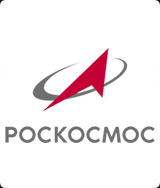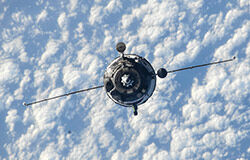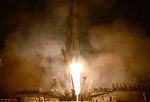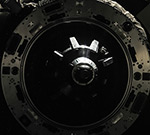Soyuz MS Spacecraft
Soyuz MS
Soyuz MS is the final planned upgrade of the Soyuz spacecraft. Its maiden flight was in July 2016 with mission MS-01.
Major changes include:
- more efficient solar panels
- modified docking and attitude control engine positions for redundancy during docking and de-orbit burns
- new Kurs NA approach and docking system which weighs half as much and consumes a third of the power of previous system
- new TsVM-101 computer, about one eighth the weight (8.3 kg vs. 70 kg) and much smaller than the previous Argon-16 computer
- unified digital command/telemetry system (MBITS) to relay telemetry via satellite, and control spacecraft when out of sight of ground stations; also provides the crew with position data when out of ground tracking range
- GLONASS/GPS and Cospas-Sarsat satellite systems for more accurate location during search/rescue operations after landing
The Soyuz MS-02 spacecraft had its maiden flight on October 19, 2016, to launch Expedition 49-50 from Baikonur with three crew members
Soyuz MS Improvements
The Soyuz MS received the following upgrades with respect to the Soyuz TMA-M:
- The power supply system SEP (Russian: CЭП, Система Электропитания) still uses fixed solar panels. But photovoltaic cells efficiency was improved to 14% (from 12%) and collective area was increased by 1.1 m2 (12 sq ft).
- A fifth 906V battery with 155 Ampere-hour capacity was added to support the increased energy consumption from the improved electronics.
- Additional micro meteoroid protection was added to the BO orbital module.
- New computer (TsVM-101), weighs one-eighth that of its predecessor (8.3 kg vs. 70 kg) while also being much smaller than the previous Argon-16 computer.
- While as of July 2016 it is not known if the propulsion system is still called KTDU-80, it has been significantly modified. While previously the system had 16 high thrust DPO-B and six low thrust DPO-M in one propellant supply circuit and six other low thrust DPO-M on a different circuit, now all 28 thrusters are high thrust DPO-B, arranged in 14 pairs. Each propellant supply circuit handles 14 DPO-B, with each element of each thruster pair being fed by a different circuit. This provides full fault tolerance for thruster or propellant circuit failure. The new arrangement adds fault tolerance for docking and undocking with one failed thruster or de-orbit with two failed thrusters. Also, the number of DPO-B in the aft section has been doubled to eight, improving the de-orbit fault tolerance.
- The propellant consumption signal, EFIR was redesigned to avoid false positives on propellant consumption.
- The avionics unit, BA DPO (Russian: БА ДПО, Блоки Автоматики подсистема Двигателей Причаливания и Ориентации), had to be modified for all this changes in the RCS.
- Instead of relying on ground stations for orbital determination and correction, the now included Satellite Navigation System ASN-K (Russian: АСН-К, Аппаратура Спутниковой Навигации) relying on GLONASS and GPS signals for navigation. It uses four fixed antennas to achieve a positioning accuracy of 5 m (16 ft), with the objective to reduce that number to as little as 3 cm (1.2 in) and an attitude accuracy of 0.5°.
- The old radio command system, the BRTS (Russian: БРТС Бортовая Радио-техническая Система) that relied on the Kvant-V was replaced with an integrated communications and telemetry system, EKTS (Russian: ЕКТС, Единая Kомандно-Телеметрическая Система). It can use not only the VHF and UHF ground stations but thanks to the addition of an S band antenna, the Lutch Constellation as well, to have theoretical 85% of real time connection to ground control. But since the S band antenna is fixed and Soyuz spacecraft cruises in a slow longitudinal rotation, in practice this capability might be limited due to lack of antenna pointing capability. It may also be able to use the American TDRS and the European EDRS in the future.
- The old information and telemetry system MBITS (Russian: МБИТС, МалогаБаритная Информационно-Телеметрическая Система) has been fully integrated into the EKTS.
- The old VHF radio communication system (Russian: Система Телефонно-Телеграфной Связи) Rassvet-M (Russian: Рассвет-М) was replaced with the Rassvet-3BM (Russian: Рассвет-3БМ) system that has been integrated into the EKTS.
- The old 38G6 antennas are replaced with four omnidirectional antenna (two on the solar panels tips and two in the PAO) plus one S band phased array, also in the PAO.
- The descent module communication and telemetry system also received upgrades that will lead to eventually having a voice channel in addition to the present telemetry.
- The EKTS system also includes a COSPAS-SARSAT transponder to transmit its coordinates to ground control in real time during parachute fall and landing.
- All the changes introduced with the EKTS enable the Soyuz to use the same ground segment terminals as the Russian Segment of the ISS.
- The new Kurs-NA (Russian: Курс-НА) automatic docking system is now made indigenously in Russia. Developed by Sergei Medvedev of AO NII TP, it is claimed to be 25 kg (55 lb) lighter, 30% less voluminous and use 25% less power. An AO-753A phased array antenna replaced the 2AO-VKA antenna and three AKR-VKA antennas, while the two 2ASF-M-VKA antenna were moved to fixed positions further back.
- The docking system received a backup electric driving mechanism.
- Instead of the analog TV system Klest-M (Russian: Клест-М), the spacecraft uses a digital TV system based on MPEG-2, which makes it possible to maintain communications between the spacecraft and the station via a space-to-space RF link and reduces interferences.
- A new Digital Backup Loop Control Unit, BURK (Russian: БУРК, Блок Управления Резервным Контуром), developed by RSC Energia, replaced the old avionics, the Motion and Orientation Control Unit, BUPO (Russian: БУПО, Блок Управления Причаливанием и Ориентацией) and the signal conversion unit BPS (Russian: БПС, Блок Преобразования Сигналов).
- The upgrade also replaces the old Rate Sensor Unit BDUS-3M (Russian: БДУС-3М, Блок Датчиков Угловых Скоростей) with the new BDUS-3A (Russian: БДУС-3А).[11][12][16]
- The old halogen headlights, SMI-4 (Russian: СМИ-4), have been replaced with the LED powered headlight SFOK (Russian: СФОК).
- A new black box SZI-M (Russian: СЗИ-М, Система Запоминания Информации) that records voice and data during the mission was added under the pilot’s seat in the descent module. The dual unit module was developed at AO RKS corporation in Moscow with the use of indigenous electronics. It has a capacity of 4GB and a recording speed of 256Kilobyte/s.[18] It is designed to tolerate falls of 150 m/s (490 ft/s) and is rated for 100,000 overwrite cycles and 10 reuses. It can also tolerate 700 °C (1,292 °F) for 30 minutes.











TikTok: tiktok.com/@olegmks
ВКонтакте: vk.com/olegmks
YouTube: youtube.com/c/OlegMKS
Яндекс.Дзен: zen.yandex.ru/olegmks
RuTube: rutube.ru/channel/23320330/